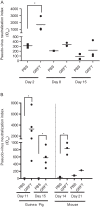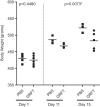Activity of and effect of subcutaneous treatment with the broad-spectrum antiviral lectin griffithsin in two laboratory rodent models
- PMID: 24145548
- PMCID: PMC3910741
- DOI: 10.1128/AAC.01407-13
Activity of and effect of subcutaneous treatment with the broad-spectrum antiviral lectin griffithsin in two laboratory rodent models
Abstract
Griffithsin (GRFT) is a red-alga-derived lectin that binds the terminal mannose residues of N-linked glycans found on the surface of human immunodeficiency virus type 1 (HIV-1), HIV-2, and other enveloped viruses, including hepatitis C virus (HCV), severe acute respiratory syndrome coronavirus (SARS-CoV), and Ebola virus. GRFT displays no human T-cell mitogenic activity and does not induce production of proinflammatory cytokines in treated human cell lines. However, despite the growing evidence showing the broad-spectrum nanomolar or better antiviral activity of GRFT, no study has reported a comprehensive assessment of GRFT safety as a potential systemic antiviral treatment. The results presented in this work show that minimal toxicity was induced by a range of single and repeated daily subcutaneous doses of GRFT in two rodent species, although we noted treatment-associated increases in spleen and liver mass suggestive of an antidrug immune response. The drug is systemically distributed, accumulating to high levels in the serum and plasma after subcutaneous delivery. Further, we showed that serum from GRFT-treated animals retained antiviral activity against HIV-1-enveloped pseudoviruses in a cell-based neutralization assay. Overall, our data presented here show that GRFT accumulates to relevant therapeutic concentrations which are tolerated with minimal toxicity. These studies support further development of GRFT as a systemic antiviral therapeutic agent against enveloped viruses, although deimmunizing the molecule may be necessary if it is to be used in long-term treatment of chronic viral infections.
Figures







References
-
- Helle F, Vieyres G, Elkrief L, Popescu CI, Wychowski C, Descamps V, Castelain S, Roingeard P, Duverlie G, Dubuisson J. 2010. Role of N-linked glycans in the functions of hepatitis C virus envelope proteins incorporated into infectious virions. J. Virol. 84:11905–11915. 10.1128/JVI.01548-10 - DOI - PMC - PubMed
Publication types
MeSH terms
Substances
Grants and funding
LinkOut - more resources
Full Text Sources
Other Literature Sources
Medical
Miscellaneous

